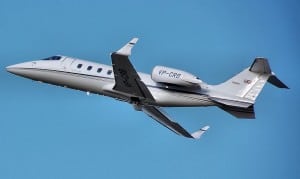Honeywell Exec: Business Aviation Forecast Spells Good News for Satellite
[Via Satellite 10-24-13] The in-flight connectivity market remains one of the major talking points in the satellite issues as FSS and MSS players jockey for position in this market. This week, Honeywell, one of the major players in the aviation market, released its 22nd annual Business Aviation Outlook report covering the changing nature of the business aviation market, which is also a target for in-flight connectivity services involving satellite technology.
The market is vibrant and Honeywell expects that there will be up 9,250 deliveries of new business jets valued at more than $250 billion by 2023. Carl Esposito, vice president of marketing and product management, Honeywell Aerospace, told Via Satellite that the demand for connectivity among business aviation customers is good news for the satellite industry.
“One of the things we see from business aviation customers is a demand for connectivity. They want their aircraft to be connected in-flight. They need to continue to do business in-flight. So, that drives a large demand for satellite connectivity. We have seen interest in all sizes of aircraft from helicopters to large business jets. So, we need to keep those aircraft connected, both from a maintenance, operation and passenger perspective,” Esposito said.
While a lot of talk is on the commercial airline market, business jet customers are constantly upgrading their communications systems, according to Esposito. “At the high end of the business jet market, such as the Gulfstream G650 or a Falcon F7X, satcom is really standard equipment. All of those aircraft come out of the factory with satellite communications. We have seen satcom be a great upgrade for existing aircraft, and we have seen customers upgrade their satcoms systems two or three times, as bandwidth availability increases and system capability increases. Just like people do with their cell phones, people upgrade their satcoms systems to get more speed,” he said.
The report also drills down into regional trends. In Asia, Honeywell says operators report new jet acquisition plans equivalent to 24 percent of their fleet. This is lower than the 34 percent reported last year, and has slipped below the world average despite “solid contributions” from China. In terms of Latin America, the company says that 39 percent of the sample fleet will be replaced or added to with new jet purchases, which is unchanged versus last year’s result. Furthermore, planned acquisitions remain more front-loaded than the world average, with almost 52 percent of this region’s projected purchases timed to happen within the next three-year period. In North America, Honeywell says new jet purchase plan levels have improved – about three points – to the world standard of 28 percent after averaging near 25 percent for the past six years. Though buying plan levels might be moderate when compared with emerging markets, North America represents more than half of projected global demand for the next five years based on the region’s historically dominant installed business jet base, affirming the region’s indisputable importance to the industry’s future, according to the Honeywell report.
The report also discusses the opportunities for business in the BRIC countries in terms of business aviation. “When you think about the BRIC countries, there are really no air-to-ground systems in any of them. There is no air to ground infrastructure for passenger communications. So, they have to go satellite. Even smaller aircraft operating domestically within those countries are going over satellite,” said Esposito. “To get to those countries is often a six to eight hour flight. You are flying over long distances and oceanic regions. So, this is also fuelling demand for satellite connectivity. We are not only excited with the systems we offer today through Inmarsat and Iridium, but we are excited to see the future for Inmarsat Ka-band.”
Esposito thinks in terms of satellite adoption in the business aviation market, that BRIC countries will see stronger and higher adoption because there is no air to ground alternative in those countries. He says in the United States, there is an air-to-ground network, where as in the rest of the world, “you will need satellite to stay connected.”
Ironically, when asked about what was the biggest surprise, Esposito cited developments in the Brazilian business aviation market. “We were also pleasantly surprised by the strong purchase expectations in Brazil. It has been strong in past surveys and it has continued to remain strong. That is a good thing for the industry. Brazil is a huge country with a large landmass. So, business aviation definitely has a value there. Brazil is investing in air traffic control infrastructure like the Honeywell Ground Based Augmentation System (GBAS) to get ready for the World Cup and Olympics and that will bring all types of air traffic into Brazil,” he said.
As one of the major trends underlining this version of the report, Esposito highlighted the trend toward larger aircraft and longer-range aircraft, which bodes well for satellite connectivity. “Those aircraft are flying oceanic routes, they are in the air a long time and they need to stay connected through satellite communications. That was a big finding,” he said.
